Physical Address
304 North Cardinal St.
Dorchester Center, MA 02124
Metastases account for approximately 8% of malignant ovarian neoplasms in women undergoing surgery for an adnexal mass in the United States. Metastases derived from nongynecologic sites are 11 times more common than those originating from the female genital tract, with adenocarcinomas of gastrointestinal tract being most frequent. Ovarian metastases are not infrequently encountered in women with disseminated cancer, and when a nonovarian primary origin has already been established, recognition of the ovarian tumor(s) as metastatic is not difficult. Metastases to the ovaries are also usually readily diagnosed as such when they exhibit characteristic gross and microscopic features. However, not infrequently, they share features with primary neoplasms, making recognition difficult, particularly when the primary site has not been identified. In the setting of metastatic ovarian neoplasia from the uterus, distinction is further complicated by the occurrence of synchronous independent ovarian and endometrial carcinomas, which often have similar morphologic characteristics.
A number of clinical, gross, and microscopic features are characteristic of metastatic involvement of the ovaries ( Boxes 17.1–17.3 ). It should be emphasized, however, that none of these features are pathognomonic. Metastases are more easily recognized when a combination of features is present, yet some metastases lack all the characteristic features and require ancillary techniques to establish a correct diagnosis.
Bilateral involvement
Size <10 cm
Surface and/or superficial cortical involvement
Nodular growth
Infiltrative growth pattern with stromal desmoplasia
Signet-ring cell component
Hilar involvement or lymph-vascular space invasion
Known history of nonovarian primary tumor
Unilateral involvement
Size >13 cm
Lack of surface and/or superficial cortical involvement
Absence of nodularity
Cyst formation
Necrosis
Low-grade areas suggesting a primary ovarian benign or borderline lesion
Stromal luteinization
Metastases to the ovaries can present synchronously or metachronously with the primary nonovarian neoplasm. In the former, diagnosing metastatic disease is usually straightforward. In contrast, the latter scenario represents a frequent pitfall, particularly when the tumor is confined to the ovary(s) and characteristic gross and histologic features of metastases are lacking. In exceptional cases, the primary site cannot be established on pathologic grounds, and only clinical investigation and follow-up over time allow identification of the tumor origin. Finally, metastatic neoplasms can cause virilization, simulating the clinical presentation of a primary ovarian sex cord-stromal neoplasm. Although relatively rare, this phenomenon is most frequently encountered with metastatic mucinous carcinomas, particularly those with signet-ring cells (Krukenberg tumor) in young women during pregnancy.
Characteristic gross features of metastases in the ovaries include smaller size (often <10 cm), bilateral involvement, nodular growth, and the presence of tumor on the ovarian surface. Nodular tumors are typically solid or solid and cystic secondary to necrosis; however, it is important to be aware that metastases can be large (>13 cm), unilateral, and cystic, simulating a primary ovarian neoplasm.
As with any ovarian mass, representative sampling of all tumor areas is required, including solid and cystic components, the interface with necrotic and hemorrhagic areas, and the ovarian surface. This is particularly important for mucinous tumors, since many of the features indicative of metastasis are present only focally in this tumor category. Thus, it is generally recommended that mucinous ovarian tumors undergo extensive sampling (at a ratio of one section per centimeter of tumor greatest dimension in tumors less than 10 cm, and two sections per centimeter if the tumor is 10 cm or more in size).
Characteristic histologic features of metastases include nodular architecture with multifocal involvement of the ovarian surface and superficial cortex, hilar, and lymph-vascular spaces. Most metastases have infiltrative growth and stromal desmoplasia. However, some have a confluent glandular or expansile growth simulating either a primary ovarian borderline tumor with intraepithelial carcinoma or a well-differentiated carcinoma, usually of mucinous or endometrioid type. The presence of signet-ring cells strongly suggests metastases, most commonly of gastrointestinal or breast origin. Certain other histologic features are characteristic of particular types of metastatic carcinomas, such as a garland pattern of epithelium surrounding so-called “dirty necrosis” in metastatic colorectal carcinoma. Histologically, benign-appearing and low-grade proliferative mucinous epithelium, simulating cystadenomata and borderline tumor, is characteristic of metastatic mucinous neoplasms of the cecal appendix. Similarly, bland mucinous proliferations associated with stromal luteinization can be seen in metastatic carcinomas of pancreaticobiliary origin.
In general, the prognosis and therapy of metastatic carcinomas to the ovary are highly dependent on the specific primary tumor. Ovarian metastases derived from nongynecologic origin qualify as stage IV disease and as such generally have a poor outcome. In contrast, metastases from a gynecologic primary (typically cervix or endometrium), if isolated, may connote a better prognosis.
Metastases of colorectal adenocarcinoma represent the most common metastatic tumor to the ovary. Most patients have a primary in the rectosigmoid. Patients are typically in their fifth to ninth decades, but occasionally, they can be younger. In some instances, the adnexal mass(es) occurs in patients with a known diagnosis of colorectal carcinoma, but in others (up to 30%), the adnexal mass(es) is the first manifestation of a synchronously or subsequently identified colorectal carcinoma, the latter posing a diagnostic challenge at the time of frozen section evaluation. Patients most commonly present with pelvic or abdominal pain or signs and symptoms related to a colorectal primary, such as rectal bleeding or symptoms of obstruction.
Tumors are bilateral in 25%–60% of patients, with median sizes ranging from 11 cm to 15 cm. The cut surfaces are variably solid and cystic ( Fig. 17.1 ), and hemorrhage and necrosis are common.
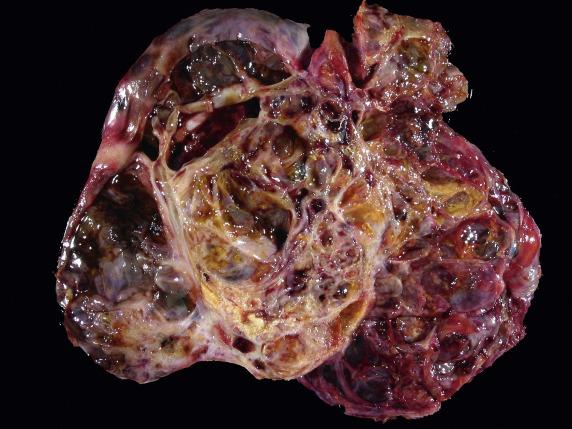
Colorectal adenocarcinomas are composed of variably sized glands, ranging from small to large and cystically dilated ( Fig. 17.2 ), or can display complex architecture with cribriforming or papillary patterns ( Fig. 17.3 ). The cells lining the glands are typically columnar, nonstratified, or multilayered and of an “endometrioid” (more frequently) or mucinous appearance, the latter ranging from focal to predominant and diffuse ( Fig. 17.4A,B ). Occasionally, the tumors are associated with abundant extracellular mucin ( Fig. 17.4C ) or have a significant signet-ring cell component. The nuclei are oval to columnar, showing notable cytologic atypia, and there is often brisk mitotic activity ( Fig. 17.5 ). A characteristic (but not pathognomic) histologic finding is the “garland pattern of dirty necrosis,” in which the epithelium is draped along the periphery of luminal eosinophilic necrotic material containing karyorrhectic debris ( Fig. 17.6A ), as well as segmental necrosis ( Fig. 17.6B ). The stroma can sometimes be desmoplastic or edematous, which helps establish the diagnosis of metastatic carcinoma. Stromal luteinization around the neoplastic glands is frequent and can be prominent and should not be interpreted as a sign of a sex cord-stromal ovarian neoplasm.
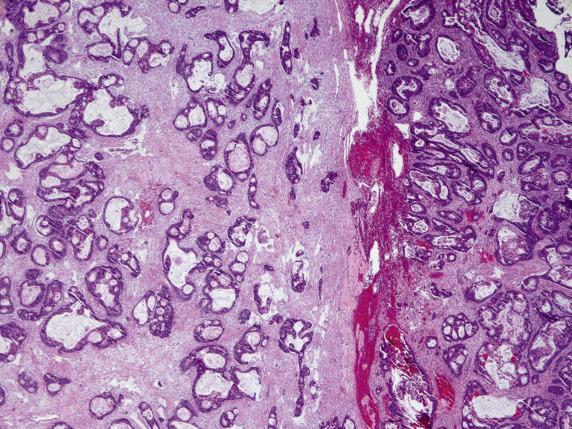
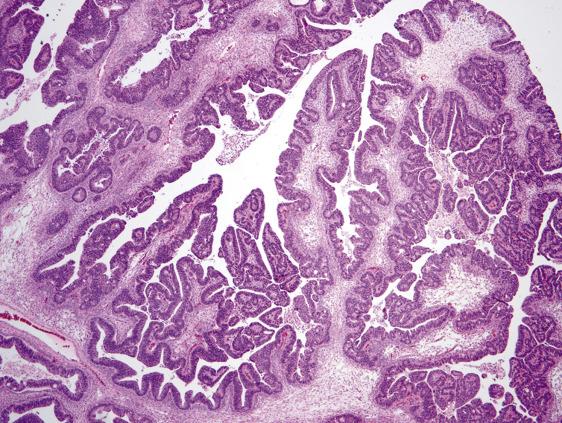
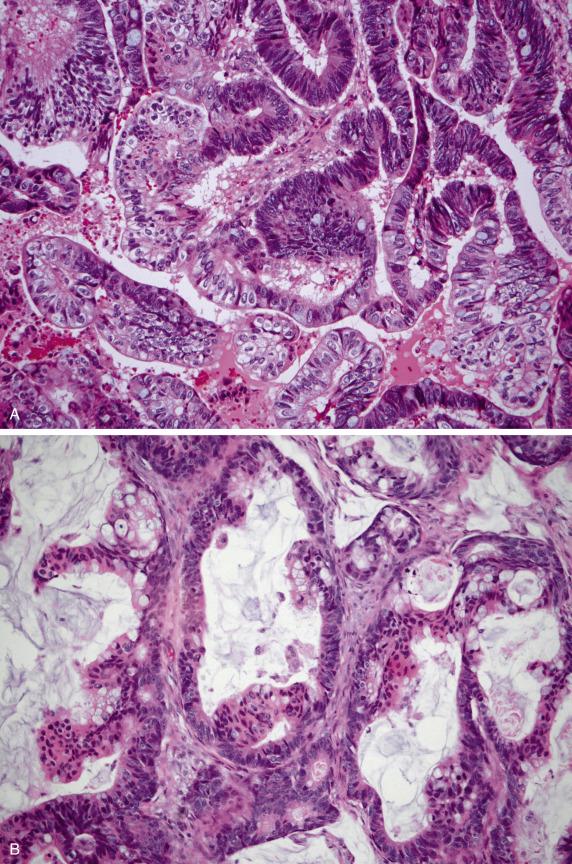
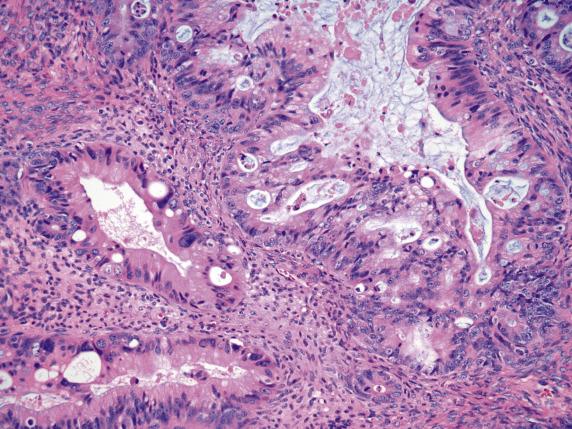
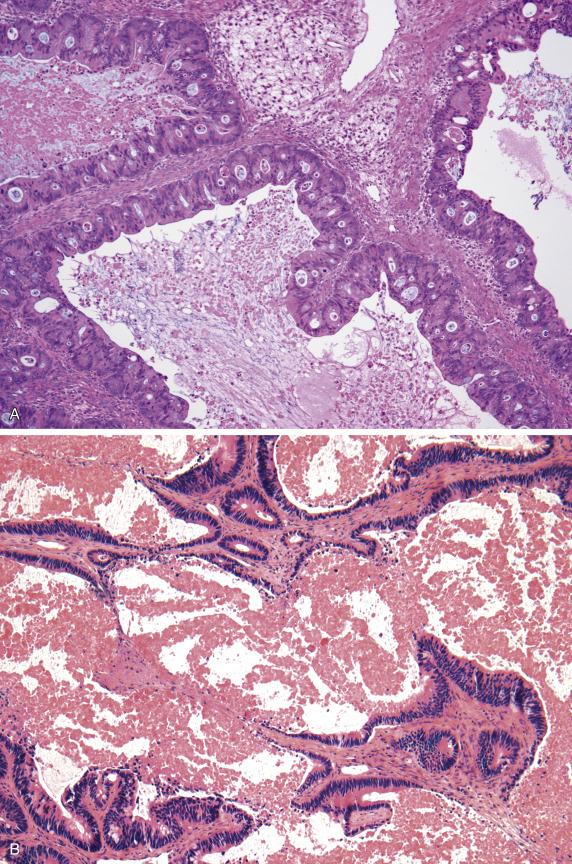
Metastatic colorectal adenocarcinomas are typically diffusely and strongly positive for CK20 and CDX2. CK7 is frequently negative; if positive, it tends to be focal except in rectal and right-sided colonic adenocarcinomas, which may exhibit extensive CK7 positivity ( Fig. 17.7 ). CDX2 has limited value in distinguishing metastatic colorectal carcinoma from primary ovarian mucinous tumors; however, it is useful in the distinction from primary ovarian endometrioid carcinomas, which are often negative (with exceptions). SATB2, a transcriptional regulator involved in osteoblastic and neuronal differentiation, has been recently reported to be a relatively sensitive and specific marker for tumors of colorectal or appendiceal origin ( Fig. 17.8 ). Primary endometrioid and mucinous carcinomas of the ovary are negative for this marker, with the important exception of intestinal-type mucinous tumors that arise in the background of a mature cystic teratoma, which are SATB2 positive. Nuclear beta-catenin and MUC2 are positive. PAX8 and ER are negative.
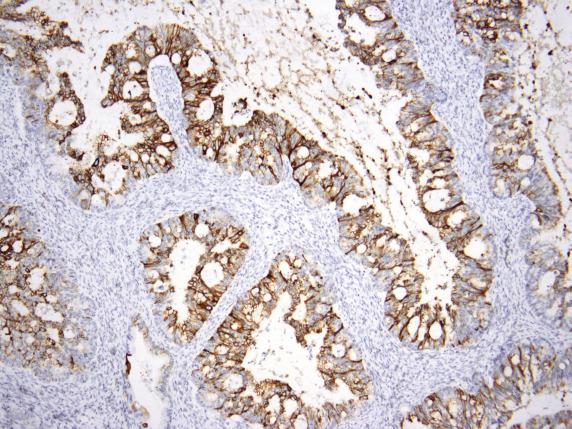
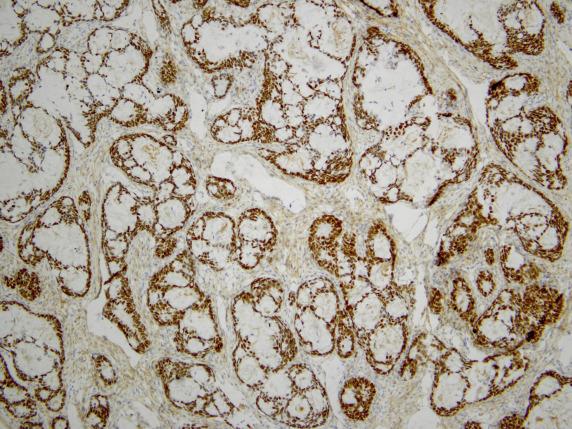
Metastatic colorectal carcinomas can simulate primary endometrioid and mucinous tumors of the ovary grossly, microscopically, and immunophenotypically. Almost half are unilateral and >13 cm, features usually seen in a primary ovarian neoplasm. In general, there is a discordance between the simple architecture (well-formed glands) and the high-grade nuclear features in metastatic colorectal carcinoma, which contrasts with endometrioid carcinoma, in which the architecture and cytology tend to be concordant. Features favoring a primary endometrioid carcinoma include foci of squamous differentiation, an adenofibromatous background, and associated endometriosis. Furthermore, these tumors are typically positive for PAX8, ER, PR, and CK7 but usually negative for SATB2, CK20, and CDX2 (with exceptions). Beta-catenin is not useful in this differential diagnosis as it can be positive in both.
The distinction of predominantly mucinous metastatic colorectal carcinoma from primary mucinous ovarian neoplasms is more challenging. Ovarian borderline mucinous tumors have low-grade cytomorphology and, although they can display crowded glands, they lack the infiltration and atypical cytomorphology of metastatic colorectal carcinoma. Primary ovarian mucinous carcinomas frequently show benign or borderline components and the general features of metastases as described earlier are typically absent. However, overlap exists: metastases can be purely confluent glandular and primary ovarian mucinous carcinomas can be infiltrative. Compared to endometrioid carcinoma, the immunohistochemical profile of primary ovarian mucinous neoplasms has a greater overlap with that of gastrointestinal tract tumors. First, primary ovarian mucinous tumors are almost always negative for ER, and PAX8 expression is seen in 50%–65% of cases (thus, a significant proportion are negative) and expression may be weak. Unlike most colorectal carcinomas, primary ovarian mucinous tumors are positive for CK7 (patchy or diffuse) and negative for SATB2 and nuclear beta-catenin. CK20 and CDX2 expression tends to be focal in primary ovarian and diffuse in metastatic colorectal tumors. MUC2 and MUC5AC show considerable overlap in staining patterns. Some primary mucinous ovarian carcinomas are associated with a teratoma; if the teratomatous component is identified, it helps establish the tumor as primary. However, an important pitfall to keep in mind is that mucinous carcinomas arising in association with teratomas show an identical immunohistochemical profile to primary intestinal tumors, including positivity for SATB2.
37% of clinically apparent metastases from nongynecologic primaries
34% of all clinically apparent metastases
Up to 10% of women with colonic carcinoma have ovarian metastases
Rectosigmoid region most common location
Fifth to ninth decades
Symptoms related to ovarian mass(es), including pelvic or abdominal pain
25%–60% bilateral
Median size: 11–15 cm
∼45% of cases are unilateral and >13 cm
Frequently solid and cystic and less commonly solid
Variably sized glands with frequent cribriform pattern
Garland pattern, “dirty” and segmental necrosis
Endometrioid-like, mucinous, or hybrid differentiation
Less frequently, abundant extracellular mucin or signet-ring cells
Columnar cells with notable nuclear atypia and brisk mitotic activity
Desmoplastic or edematous stroma
Not infrequently, periglandular stromal condensation or luteinization
CK20, CDX2, SATB2 usually diffusely positive
MUC2 and beta-catenin (nuclear) can be positive
CK7 typically negative but may be focally positive (except rectal and right sided colonic carcinomas which can be diffuse)
PAX8 and ER negative
Endometrioid carcinoma
Primary ovarian mucinous borderline tumors and carcinomas
The spectrum of primary appendiceal neoplasia involving the ovary is wide and includes, in order of frequency, low-grade appendiceal mucinous neoplasm (LAMN), appendiceal adenocarcinoma and, rarely, goblet cell carcinoid. Patients present over a wide age range, with a mean of 46 years for LAMN and 52 for appendiceal carcinoma. Most patients with LAMN present with mucinous ascites (pseudomyxoma peritonei), which may be slowly progressive; in these patients, secondary ovarian involvement occurs as direct spread from pseudomyxoma peritonei. Other patients present with signs and symptoms secondary to an adnexal mass or mimicking appendicitis. Patients with appendiceal carcinoma may present with abdominal swelling and pain, symptoms related to an adnexal mass and, occasionally, bowel obstruction.
The tumors are frequently bilateral (80%), but if unilateral, there is a predilection for the right side. The tumor size varies and depends on the histologic type, being larger (usually >10 cm) in LAMN. Adenocarcinoma, especially if nonmucinous, is usually >5 cm. Metastatic carcinoid varies in size, with most measuring from 5 to 10 cm. LAMNs are typically multilocular, with cysts filled with abundant dense inspissated mucin ( Fig. 17.9 ); ovarian surface involvement by mucin deposits is common. Spread from appendiceal carcinoma typically has a solid ( Fig. 17.10 ) to solid and cystic cut surface, which is often gelatinous and can show extensive necrosis.
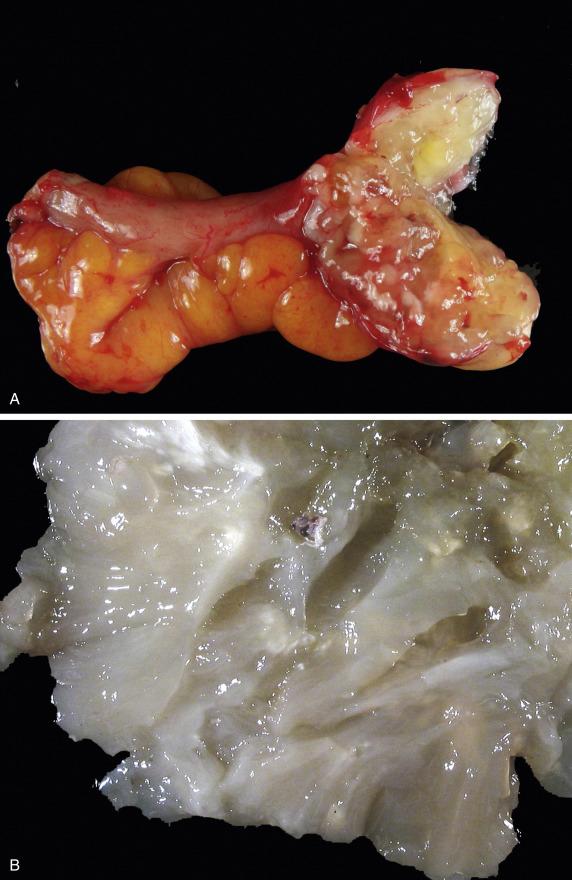
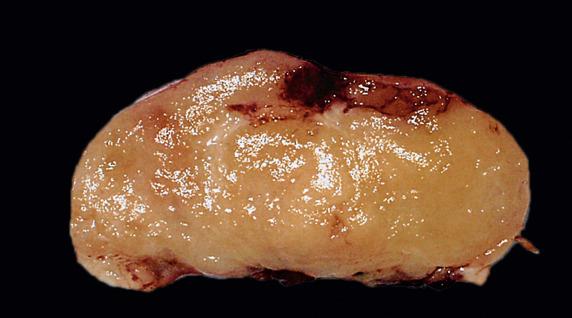
Secondary involvement by LAMN typically shows irregularly shaped, cystically dilated glands with abundant intraluminal mucin. The glands often have undulating outlines and subepithelial clefting (separation of the mucinous epithelium from the underlying stroma). Shallow outpouchings (“scalloped borders”) are characteristic as well as tall “hypermucinous” cells, which are two to three times taller than conventional ovarian mucinous epithelium ( Fig. 17.11A ). The cells are cytologically bland, with mild to moderately atypical and well-polarized nuclei with only subtle nuclear stratification and infrequent mitotic activity. Acellular mucin often dissects through the stroma (“pseudomyxoma ovarii”) and involves the ovarian surface as well as peritoneal surfaces (“pseudomyxoma peritonei”) ( Fig. 17.11B ). Metastases of appendiceal carcinomas may be of the intestinal (with variable amounts of mucin), colloid, Krukenberg type, or mixtures thereof and show a variety of growths including individual signet-ring cells within a cellular stroma (Krukenberg tumor) to small- and medium-sized glands (intestinal) to single cells and nests floating in pools of mucin (colloid) ( Figs. 17.12–17.14 ). Tubules, cords, and trabeculae may also be seen. Cytologic atypia and brisk mitotic activity are common.
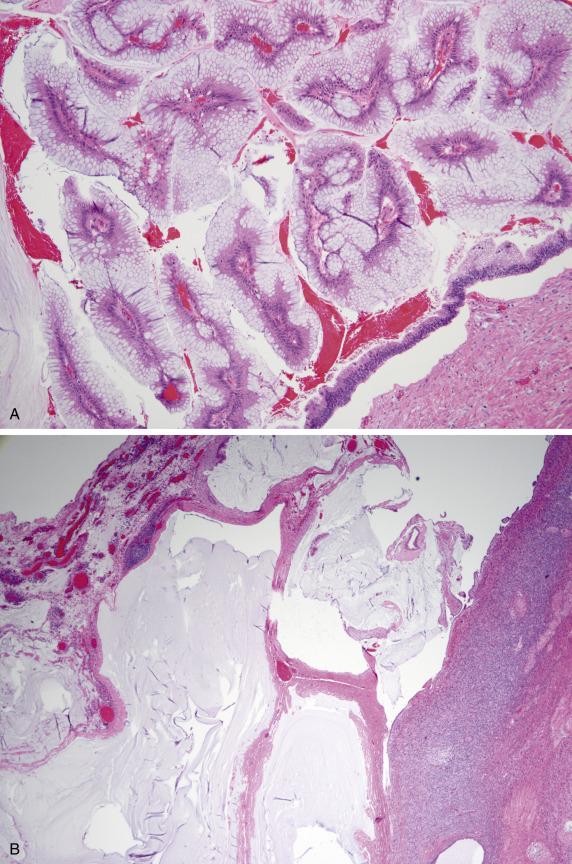
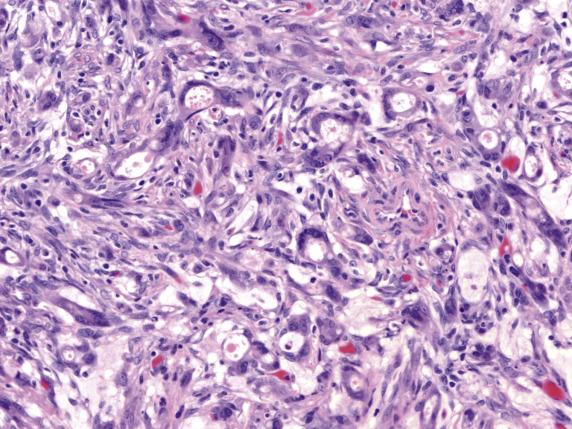
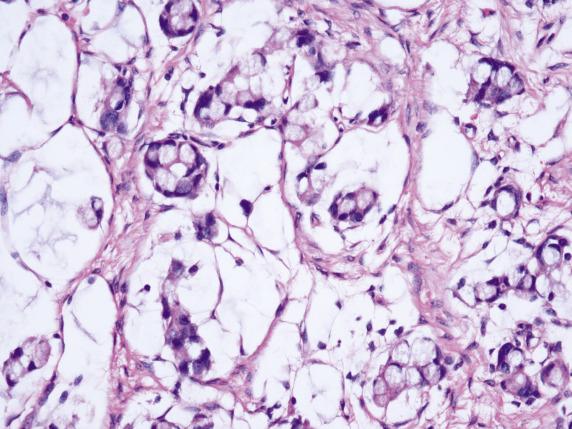
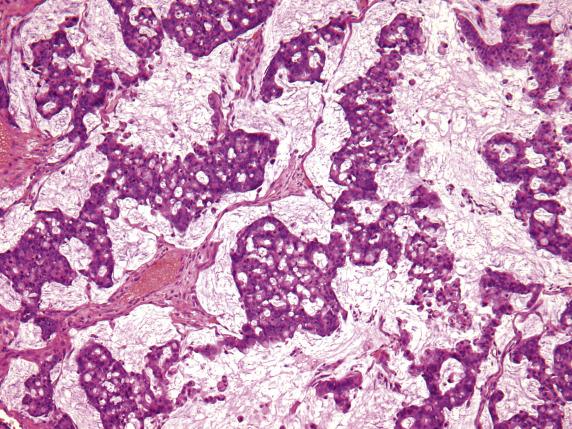
LAMNs are typically positive for SATB2, CK20, CDX2, and villin in a diffuse and strong fashion. CK7 may be variably positive but is usually focal. In general, MUC2 is typically positive, MUC1 and MUC5AC may be positive, and MUC6 is negative. Appendiceal adenocarcinomas also express CK20, CDX2 (diffusely), and SATB2. CK7 is more often negative, but it can be seen in approximately 40% of cases, including signet-ring cells, and may be patchy or diffuse (it is generally somewhat weaker than CK20 expression) ( Fig. 17.15A,B ). MUC2 is typically positive, MUC1 and MUC5AC may be positive, and MUC6 is negative.
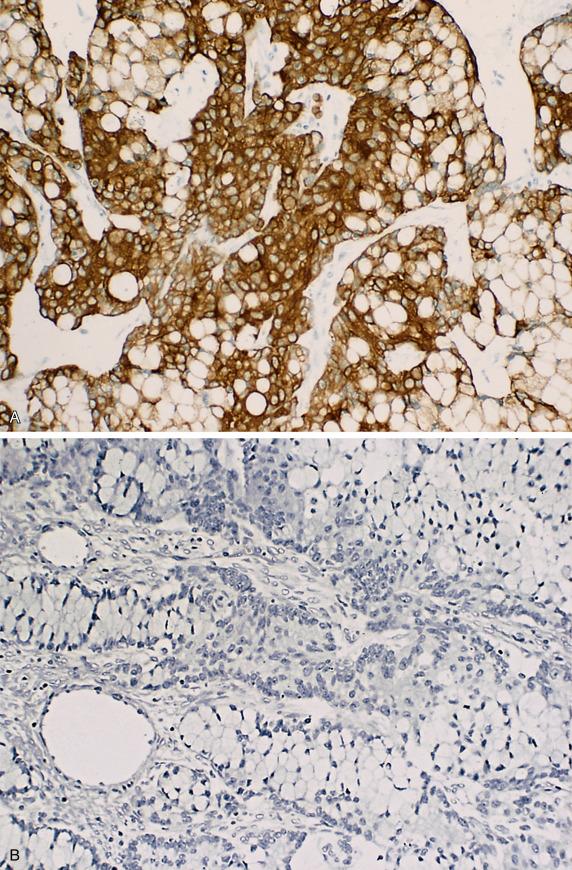
The main differential diagnosis for metastatic LAMN to the ovary is an ovarian borderline mucinous tumor . The latter is almost always unilateral and large (mean size 22 cm), and lacks pseudomyxoma peritonei and ovarian surface involvement. At low power magnification, the glands show complex intraluminal papillary growth and tufting and are associated with cellular stroma as well as histiocytic aggregates secondary to gland rupture. They typically lack subepithelial clefts, scalloped glands, tall cells, and pseudomyxoma ovarii.
The differential diagnosis of metastatic appendiceal mucinous carcinoma (and, much less commonly, LAMN) is with an ovarian mucinous carcinoma . These are unilateral and typically large (>15 cm); histologically, most are well differentiated and show cytomorphology similar to mucinous borderline tumors. There is, however, significant overlap between appendiceal and mucinous lesions.
By immunohistochemistry, LAMN and appendiceal mucinous adenocarcinoma have important differences in expression from primary mucinous neoplasms. A SATB2-positive PAX8-negative profile will be in keeping with appendiceal origin; conversely, a SATB2-negative, PAX8-positive result is indicative of a primary ovarian mucinous tumor, with the caveat that 30%–50% of ovarian mucinous tumors are negative for PAX8. Diffuse and strong expression of CK7 is more in keeping with a primary ovarian tumor, whereas diffuse and strong CK20 and CDX2 expression favors appendiceal origin; patchy staining for these markers is not specific.
It is important to keep in mind that mature cystic teratoma can give rise to intestinal-type mucinous neoplasms, including LAMN. In this context, the neoplasm will display the features of metastases listed earlier, including SATB2 expression. However, they are typically unilateral and tend to be larger than metastatic LAMNs (average 21 cm vs. 14 cm, respectively). Moreover, residual benign teratoma may be present in the periphery of the tumor. This feature highlights the importance of extensive tumor sampling in the context of an ovarian mucinous neoplasm.
Metastatic nonmucinous appendiceal carcinomas should be distinguished from endometrioid carcinoma . The latter is usually unilateral, frequently associated with endometriosis or adenofibroma, lacks signet-ring cells and vascular invasion, and is PAX8 positive and CK20 negative. Of note, endometrioid carcinomas can be CDX2 positive, which can sometimes be extensive and thus be a potential pitfall in this differential diagnosis.
Uncommon
Most likely low grade appendiceal mucinous neoplasm (LAMN)
Adenocarcinoma less frequent
LAMN: mean 46 years
Carcinoma: mean 52 years
LAMN: slowly progressive abdominal symptoms
Pseudomyxoma peritonei (low-grade mucinous tumor > carcinoma)
Pelvic/adnexal mass
Symptoms of “appendicitis” occasionally
80% bilateral (LAMN and carcinoma)
If unilateral, right ovary more commonly involved
Variable size (typically >10 cm for LAMN and mucinous adenocarcinoma)
Surface mucin deposits
Cut surface
LAMN: multilocular with intracystic inspissated mucin
Adenocarcinoma: solid or solid and cystic with ± necrosis
LAMN involving ovary
Irregularly shaped and cystically dilated glands
Abundant intraluminal mucin
Glands with undulating outlines, subepithelial clefting and scalloped borders
Tall “hypermucinous” cells at least focally
Mild to moderate nuclear stratification and cytologic atypia
Mitotic activity not brisk
Pseudomyxoma ovarii and peritonei
Appendiceal adenocarcinoma involving ovary
Intestinal (small to medium sized glands) with variable amounts of intracytoplasmic mucin
Colloid (nests and single cells floating in pools of mucin)
Krukenberg (>10% signet-ring cells)
Cytologic atypia and brisk mitotic activity common
LAMN
CK20, CEA, SATB2, CDX2, villin positive
CK7 variably positive (typically focal)
MUC2 positive, MUC1 and MUC5AC may be positive, MUC6 negative
Adenocarcinoma
CK20, CDX2 and SATB2 diffusely positive
CK7 positive in 40% including signet-ring cells (patchy or diffuse)
MUC2 positive, MUC1 and MUC5AC may be positive, MUC6 negative
Primary mucinous ovarian neoplasms (borderline and malignant)
Endometrioid carcinoma
Primary ovarian goblet cell (mucinous) carcinoid tumor
Metastasis from this anatomic location are more likely to exhibit a poorly cohesive (signet-ring cell) phenotype (namely Krukenberg tumor) but also may be of the tubular (intestinal) type. Poorly cohesive (signet-ring cell) carcinoma (Krukenberg tumor), also termed the diffuse type, should, by definition, have signet-ring cells comprising >10% of the tumor; tubular (intestinal-type) tumors may also have signet-ring cells, but they comprise <10%. Patients range in age from 20 to 70 years, but, typically, those with poorly cohesive (signet-ring) cell carcinomas are younger (mean 40 years), whereas those with tubular (intestinal) type are usually older (mean 60 years). Most patients have symptoms related to an adnexal mass (most commonly abdominal swelling, pain or ascites), with the remainder having gastrointestinal symptoms and weight loss. Infrequently, hormonal manifestations, either virilization (if androgenic) or vaginal bleeding (if estrogenic), may occur in Krukenberg tumors. A history of a prior gastric carcinoma is present in only approximately one-quarter of the patients.
Tumors are commonly bilateral (80%) especially if poorly cohesive (signet-ring) cell carcinoma. Although size of tumors may be quite variable (up to 18 cm), the average is 6 cm for tubular (intestinal-type) and 10 cm for poorly cohesive (diffuse-type) carcinomas. Most signet-ring cell carcinomas are solid and bosselated with a multinodular cut surface that has alternating white to yellow and glistening areas ( Fig. 17.16 ). Foci of hemorrhage and necrosis are commonly present. In contrast, intestinal-type carcinomas are solid and cystic; the cysts can be quite large (up to 6 cm) and often filled with mucinous secretions or hemorrhage.
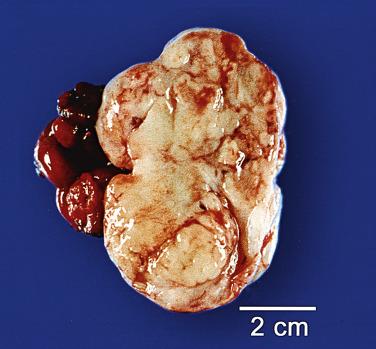
Carcinoma metastatic from the stomach is usually of the poorly cohesive (diffuse signet-ring cell type). Thus, most metastatic gastric tumors fulfill the definition of Krukenberg tumor (metastatic adenocarcinoma with signet-ring cells that comprise >10% of the tumor). At low-power scrutiny, cellular and hypocellular areas often alternate, imparting a pseudolobular architecture. The former imparts a fibroma-like appearance ( Fig. 17.17A ), whereas the latter is secondary to edema and/or myxoid stroma. The neoplastic cells predominate in the hypercellular areas ( Fig. 17.17B ). Not infrequently, there is an abrupt transition between the two components ( Fig. 17.17C ). Classically, the signet-ring cells are arranged individually or in clusters; however, they may form glands ( Fig. 17.18A ), hollow or solid tubules, and trabeculae ( Fig. 17.18B ). Less commonly, an insular, lobular, or diffuse growth may be seen ( Fig. 17.19 ). Extracellular mucin is frequently conspicuous and may be admixed with acellular collagen. The presence of cellular fibromatous stroma with luteinization is common, especially in pregnant patients. Metastatic gastric carcinoma of tubular (intestinal type) is typically composed of medium to large tubular glands ( Fig. 17.20 ) that may be dilated and have a pseudoendometrioid appearance; other less common patterns include cribriform, trabecular, and insular. Metastatic gastric carcinoma of the papillary type may also occur. A minor (<10%) signet-ring cell component may be seen. Segmental and “dirty” necrosis is frequent. In either diffuse or intestinal-type carcinomas, the signet-ring cells typically have crescentic or oval hyperchromatic nuclei and abundant eosinophilic to vacuolated cytoplasm. Rarely, their cytoplasm may have a targetoid appearance (clear vacuole with central eosinophilic body; Fig. 17.19 ). Cystic areas of intestinal-type carcinomas may be lined by bland to highly atypical cells with variable amounts of mucin. Desmoplasia is variably present.
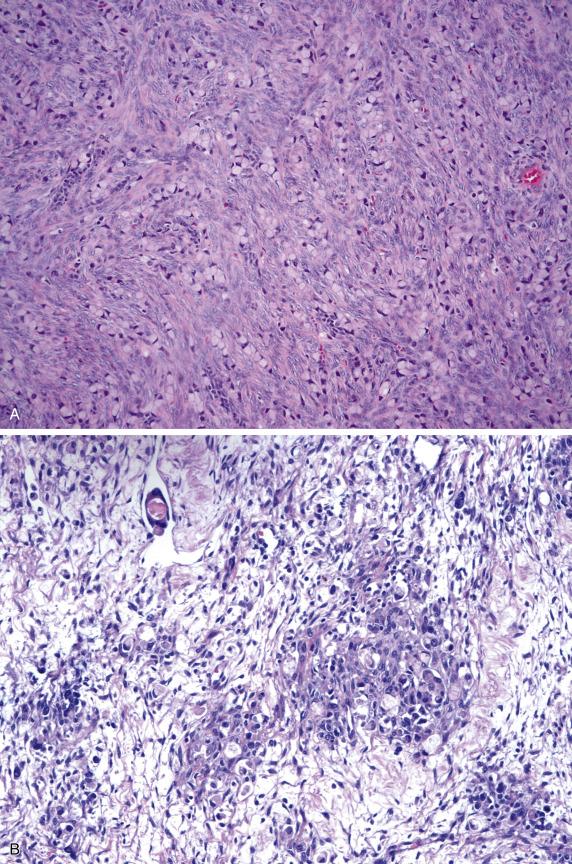
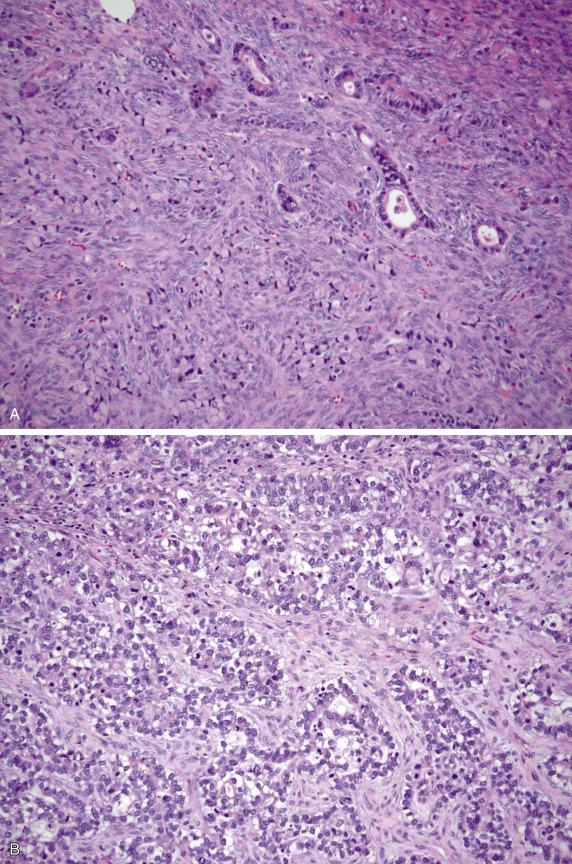
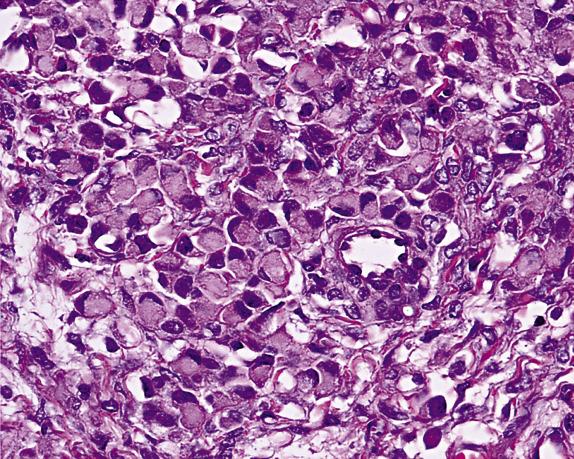
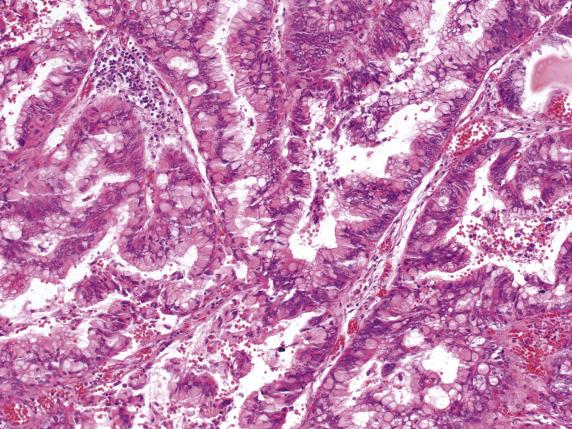
Strong CK7 expression is seen in most cases, along with CK8, CK19, and CDX2. CK20 and SATB2 show variable expression but tend to be positive (patchy). Focal positivity for chromogranin, NSE, and synaptophysin can be seen. Expression of mucins is variable, with MUC5AC being more consistently positive compared to MUC1, MUC4, and MUC6. Hormone receptors, PAX8, calretinin, inhibin, and SF1 are negative.
Since most patients lack a history of gastric malignancy at the time of presentation, a high index of suspicion is required in women with an ovarian mass(es) displaying mucinous morphology, particularly signet-ring differentiation. Importantly, signet-ring cells can be subtle and not readily apparent. For this reason, cellular fibroma and sclerosing stromal tumor are part of the differential diagnosis. At the morphologic level (including intraoperative consultation), it is most important to examine any solid mass with uniform or alternating (hypo/hypercellular) fibromatous appearance carefully at high power magnification. Identification of mucinous signet-ring cells is diagnostic and facilitated by mucin stains and cytokeratins. Signet-ring stromal tumor should neither stain for periodic acid–Schiff/mucin nor express cytokeratins. Primary mucinous carcinoid tumor may, in some areas, closely mimic a Krukenberg tumor. However, it is unilateral and displays typical areas of nesting, frequently with goblet and Paneth cell differentiation free floating in pools of mucin. Metastatic gastric carcinoma of the intestinal type should be distinguished from primary endometrioid and mucinous carcinomas . In this scenario, it is important to look for other general morphologic features seen in metastatic carcinoma to the ovary (e.g. small size, bilaterality) as immunohistochemistry has limited value. If the morphology suggests endometrioid carcinoma, a positive PAX8 will confirm such impression. Unfortunately, in the setting of a mucinous neoplasm, the work-up to distinguish between primary ovarian and secondary gastric adenocarcinoma is often inconclusive, and clinical investigation should be advised in order to exclude a gastric malignancy. Lastly, a very rare but important differential is metastatic gastric-type adenocarcinoma of the uterine cervix , which frequently involves the ovary at the time of presentation. These lesions usually have a pyloric gastric phenotype and will overlap morphologically and immunohistochemically with that of intestinal-type gastric carcinoma. Most patients have cervical abnormalities on clinical examination, which should raise the possibility of a cervical primary.
9% of clinically evident metastases from nongynecologic tumors
Mean 40 years if poorly cohesive (signet-ring cell) type (Krukenberg tumor)
Mean 60 years if tubular (intestinal) type
Diagnosis usually unsuspected
Only 25% have known history of gastric carcinoma
Symptoms related to adnexal masses or gastrointestinal complaints
Hormonal manifestations, either androgenic (virilization) or estrogenic (vaginal bleeding), more common, if Krukenberg
Commonly bilateral (up to 80%), especially if Krukenberg
Mean 6 cm if intestinal; mean 10 cm if signet-ring cell
Multinodular white to tan and glistening cut surface, if signet-ring cell
Solid and cystic, with mucinous or hemorrhagic intracystic contents, if intestinal
Poorly cohesive (diffuse/signet-ring) type (Krukenberg; defined as >10% signet-ring cell component):
Alternation of cellular (fibroma-like) and hypocellular (edematous/myxoid) areas with pseudolobular architecture
Neoplastic cells predominate in hypercellular areas
Individual or clusters of signet-ring cells more common
Conspicuous extracellular mucin
Deceptively bland to highly atypical nuclei with brisk mitotic rate
Frequent stromal luteinization (especially if pregnant)
Tubular (intestinal) type:
Medium to large tubular glands, some with pseudoendometrioid morphology; less commonly cribriform, trabecular, and insular
Signet-ring cells uncommon (if present, <10%)
Variable cytologic atypia and mitotic activity
CK7, CK8, CK19, and CDX2 typically positive
CK20 and SATB2 variably positive
MUC5AC typically positive; MUC1, MUC4, and MUC6 may be positive
ER, PR, PAX8, calretinin, inhibin and SF1 negative
Poorly cohesive (signet-ring cell) type (Krukenberg):
Cellular fibroma and sclerosing stromal tumor
Signet-ring stromal tumor
Primary mucinous carcinoid
Tubular (intestinal) type:
Endometrioid and mucinous carcinoma
Spread from the pancreaticobiliary tract to the ovaries is uncommon, representing less than 10% of clinically apparent metastases from nongynecologic tumors, with pancreatic being more common than biliary tract origin. Within the latter, gallbladder origin is most common. Patients range in age from 29 to 87 years (mean sixth decade) and usually present with nonspecific pelvic symptoms, with or without abdominal pain or discomfort, vomiting, fever, chills, jaundice, and/or weight loss. Often, there is not an established diagnosis of pancreatic carcinoma; thus, in many patients, the clinical impression is that of a primary ovarian mass.
The tumors are typically bilateral (75%–100%), often show surface involvement, and vary greatly in size, measuring up to 20 cm. The cut surfaces are more commonly solid and cystic but may be predominantly solid or multicystic. The solid areas range from white to tan or red and may be firm or spongy. Multicystic tumors filled with mucin are more often seen in metastases from the pancreas.
At low power, surface involvement may be identified ( Fig. 17.21 ), and varying degrees of differentiation, ranging from “benign appearing” to frankly malignant, are present ( Fig. 17.22A–C ). Admixtures of simple or cystically dilated glands, complex glands (including cribriforming), villiform, complex papillae, or micropapillae are characteristic. Irregularly infiltrative and relatively small glands with desmoplastic stroma are also frequently seen. Metastatic pancreaticobiliary carcinoma most often displays mucinous differentiation, including goblet cells, and is characterized by cuboidal to columnar cells showing basal to pseudostratified nuclei with varying degrees of nuclear pleomorphism and mitotic activity ( Fig. 17.23A–C ). Occasionally, tumor is more poorly differentiated and contains signet-ring cells as well as minor foci of nests, trabeculae, and single cells free floating within pools of mucin (colloid carcinoma). Although rare, pseudomyxoma ovarii may occur. The nonmucinous component is nonspecific cuboidal to columnar, sometimes with pseudoendometrioid features including secretory or hobnail appearance. The stroma varies greatly both within and among tumors; the most common is a fibromatous appearance, but a desmoplastic to hyalinized or collagenous stroma may also be seen. Stromal luteinization may also occasionally occur.
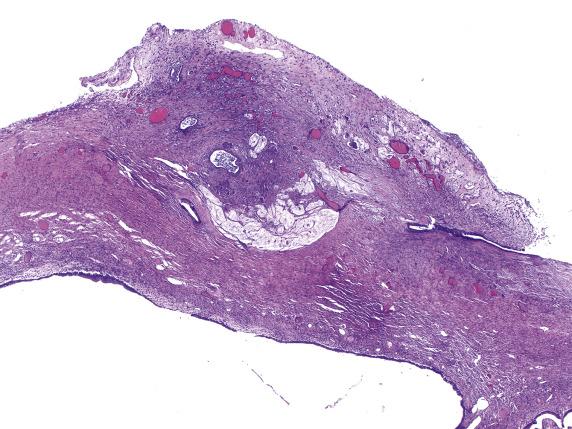
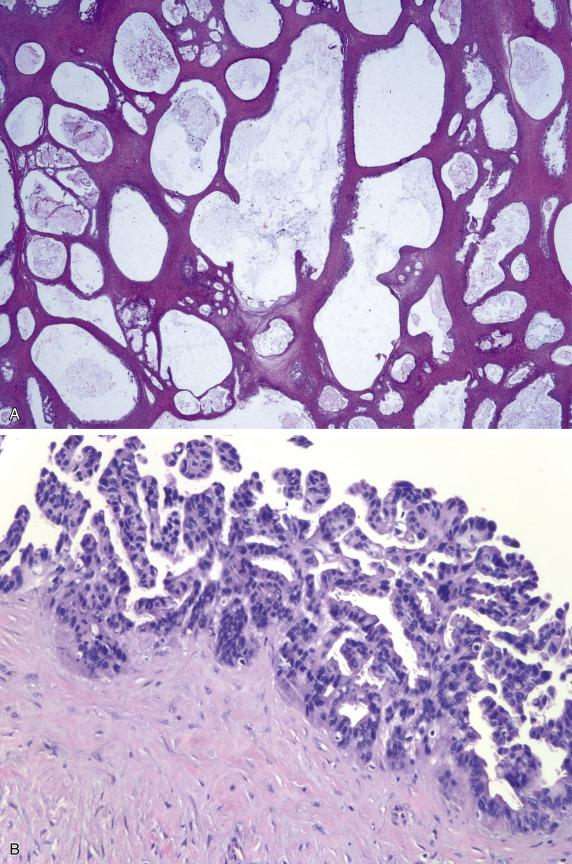

Tumors are typically diffusely positive for CK7 and frequently positive for CDX2, CK8, CK17, CK18, and CK19; CK20 usually shows patchy staining. About 70% of tumors are CK7/CK20 positive, with the remainder showing a CK7-positive/CK20-negative profile. They are also positive for MUC1, MUC4, and MUC5AC. Dpc4 is inactivated (and consequently with loss of expression) in approximately 55% of pancreatic carcinomas and 35% of bile and ampullary carcinomas ( Fig. 17.24 ).
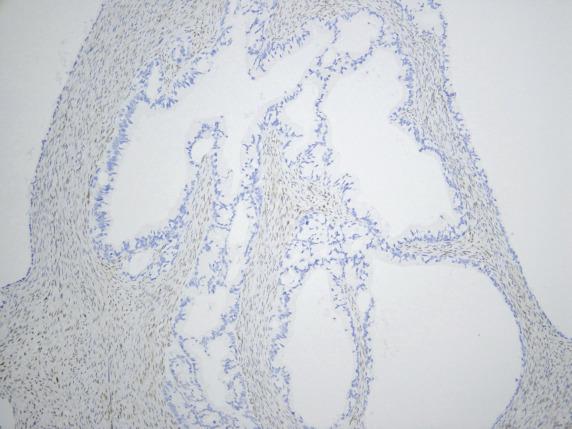
The principal differential diagnostic consideration is distinction from primary ovarian mucinous neoplasms (borderline mucinous tumors and carcinomas) , as metastatic pancreaticobiliary tumors to the ovary can simulate the transition from benign to borderline to carcinoma. Features favoring metastatic pancreatico-biliary carcinoma include bilateral and surface involvement, nodular growth, and the finding of haphazard, irregularly distributed glands having variable sizes and shapes. Metastatic pancreaticobiliary carcinoma and primary ovarian mucinous tumors share the same CK7/CK20, as well as mucin immunohistochemical profile; occasionally, pancreatic adenocarcinoma can be positive for PAX8. Loss of Dpc4 expression in an ovarian mucinous tumor supports metastatic pancreatic or biliary origin. When the tumor is composed of predominantly nonmucinous cells, the differential diagnosis includes an endometrioid and high-grade serous carcinoma . Although these primary ovarian carcinoma types may be bilateral, they are typically positive for hormone receptors. Of note, CK20 may be positive but it is usually focal. Furthermore, endometrioid carcinoma shows squamous differentiation, an adenofibromatous background or associated endometriosis, and high-grade serous carcinoma usually displays a degree of cytologic atypia and high nuclear-to-cytoplasmic ratio that exceed the expected in pancreato-biliary metastases.
Patients present over a wide age range (25 to 80 years; mean 49 years) and often have a known history of breast carcinoma. However, ovarian involvement may occasionally represent the initial manifestation of the disease. Breast carcinoma represents the second most common
75%–100% bilateral
Common surface involvement
Up to 20 cm
Solid and cystic > solid > multicystic filled with mucin (more common in pancreatic ductal carcinoma)
Varying degrees of differentiation within tumor (benign appearing to frankly malignant)
Variable admixtures of:
Simple or cystically dilated glands
Complex glands (including cribriforming)
Villiform, complex papillae, or micropapillae
Pseudomyxoma ovarii rare
Mucinous epithelium: cuboidal to columnar with variable nuclear pseudostratification; less commonly signet-ring cells, nests, trabeculae, and single cells free floating within mucin
Nonmucinous epithelium: Cuboidal to columnar (pseudoendometrioid)
Fibromatous > hyalinized or collagenous stroma
± Stromal luteinization
CK7 usually diffusely positive
CDX2, CK8, CK17, CK18, and CK19 frequently positive
CK20 often focally positive
MUC1, MUC4, and MUC5AC positive
Dpc4 loss (∼50% if pancreas; ∼35% if biliary)
PAX8 mostly negative; positive on occasion
Primary ovarian mucinous tumors
Endometrioid carcinoma
High-grade serous carcinoma
metastasis to the ovary following colon and appendix. Lobular carcinoma has a predilection to involve the ovary and other gynecologic organs over ductal carcinoma; however, as ductal carcinoma is far more common, ductal morphology is more likely to be encountered than lobular (75% vs. 25%, respectively). Up to 40% of prophylactic salpingo-oophorectomies in patients with advanced breast cancer will harbor metastatic disease.
In approximately two-thirds of cases, metastases are bilateral. The tumors are usually <5 cm, multinodular and solid ( Fig. 17.25 ); cystic and papillary tumors are unusual.
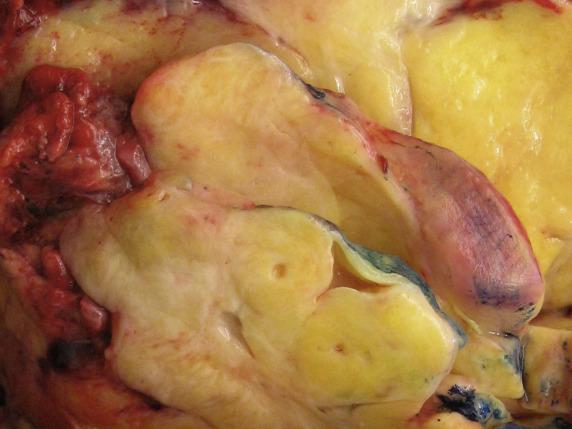
A variety of patterns can be encountered that often merge, with ductal carcinomas often displaying glandular, papillary, cribriform, or diffuse growth(s), and lobular carcinomas exhibiting characteristic single-file, cords, trabeculae, insular, nests, and diffuse growth ( Figs. 17.26–17.29 ). The tumor cells tend to have pale to eosinophilic cytoplasm and display round to oval nuclei with variable nuclear enlargement (usually not prominent). The stroma, which varies in amount, can be fibromatous, collagenous or edematous. Signet-ring cells are more often seen in lobular carcinoma and, when extensively present, often show a diffuse or corded architecture and are associated with striking edema; however, extracellular mucin is not observed (unlike Krukenberg tumors from the gastrointestinal tract). Single cells and follicle-like structures may be seen.
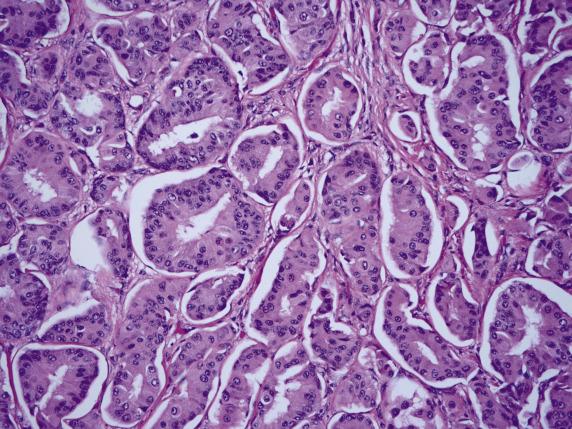

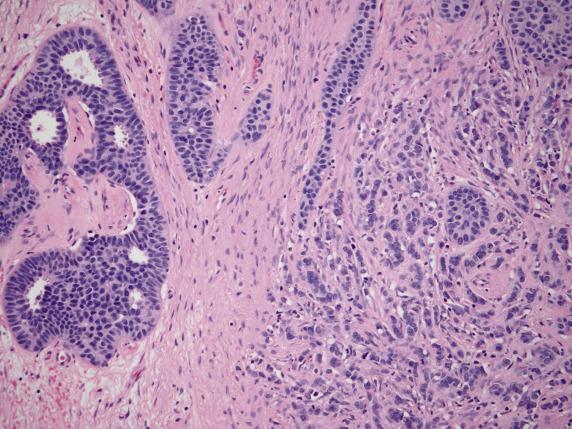
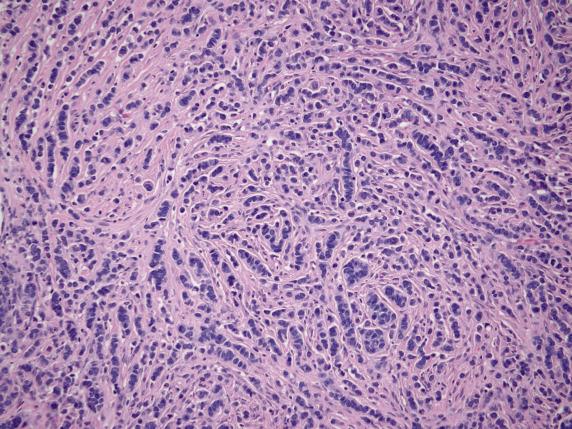
Breast carcinomas are typically positive for CK7 and GATA3 ( Fig. 17.30 ) but negative for CK20 and PAX8. Expression of ER, PR, GCDFP-15 (BRST-2), and mammaglobin is more often seen in low- to intermediate-grade ductal carcinomas and in a significant number of lobular carcinomas. It is important to note that triple negative breast carcinomas can be negative for GATA3. GCDFP-15 positivity typically establishes the diagnosis of breast carcinoma (with rare exceptions), but negative staining does not exclude this diagnosis. Most tumors do not express WT1 (seen in ∼20%).
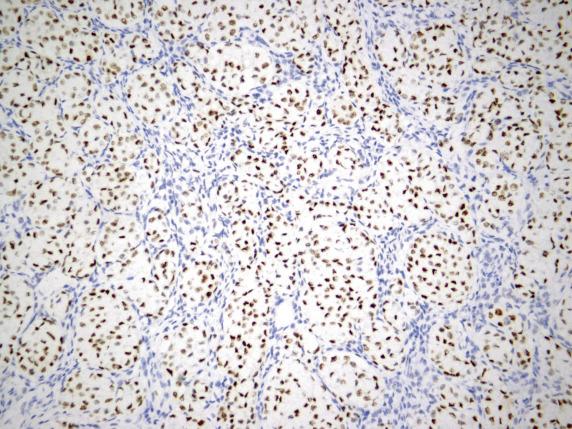
Metastatic breast carcinoma should be distinguished from primary ovarian carcinoma (most commonly serous and less commonly, endometrioid), carcinoid tumor, sex cord-stromal tumors (most commonly adult granulosa cell tumor), and lymphoma. When high grade, the appearance of a ductal carcinoma may significantly overlap with tubo-ovarian high-grade serous carcinoma . This occurs especially at the time of frozen section in patients with a genetic susceptibility for breast and ovarian cancer who have known invasive breast cancer. It is important to realize that in this setting, the more likely scenario is a second primary rather than a metastasis. ER and PR are commonly expressed in both breast and ovarian serous carcinoma. The latter is typically positive for PAX8 and WT1 (N-terminus) and negative for GATA3, GCDFP-15, and/or mammaglobin. Less commonly, the differential includes an endometrioid carcinoma . The latter often is associated with a precursor lesion (endometriosis or adenofibroma), may show squamous differentiation, and is typically positive for PAX8. In contrast to serous carcinomas, WT1 is not helpful in the distinction between endometrioid carcinoma and breast carcinoma, as both tumors are frequently negative for this marker. It is important to be aware that both endometrioid and serous carcinomas can be positive for GATA3 (usually weak). In addition to their characteristic nested growth, cytoplasmic granules, and nuclear features, carcinoid tumors are typically positive for chromogranin and synaptophysin. Although the nested and trabecular pattern of adult granulosa cell tumor may mimic that of lobular carcinoma, other characteristic patterns as well as follicles, Call-Exner bodies, and nuclear grooves are often seen in the former. They are typically positive for inhibin, SF1, and FOXL2, but it is important to keep in mind that they also often express keratins. Lymphoma / leukemia may grow in sheets and cords and involve both ovaries bilaterally as seen in breast cancer; however, the cytologic features differ and the tumors are typically keratin-negative.
Two-thirds bilateral
Usually <5 cm
Nodular >> diffuse involvement
Ductal carcinoma: glandular, papillary, cribriform, or diffuse
Lobular carcinoma: single file, cords, trabeculae, insular, and diffuse
Cells with pale to eosinophilic cytoplasm and round to oval nuclei
Variable cytologic atypia and mitotic activity
Fibromatous, collagenous or edematous stroma
Signet-ring cells may be seen
CK7 and GATA3 positive
ER, PR, mammaglobin, and GCDFP-15 more often positive in low- to intermediate-grade ductal carcinomas and ∼50% of lobular carcinomas
CK20, PAX8, and usually WT1 negative
Serous and endometrioid carcinoma
Carcinoid tumor
Sex cord-stromal tumor (most commonly adult granulosa cell tumor)
Lymphoma/leukemia
Patients range in age from 26 to 76 (mean 43) years. Presentation may include pulmonary symptoms, a history of smoking, abdominal pain/enlargement, ascites, or an abdominal/pelvic mass (if small cell carcinoma). In one study, the ovarian tumor was detected after the lung cancer in 50% of patients (at a mean interval of 1 year), but in approximately 30%, the lung and ovarian tumors occurred synchronously and in 15% the ovarian tumor preceded the discovery of the lung primary.
The tumors are commonly unilateral, but may be bilateral (one-third), with a mean size of 10 cm. The external surface is typically smooth (surface involvement is rare) and intact, whereas the cut surface is firm or soft, lobulated, white to yellow/tan, hemorrhagic, and/or necrotic with secondary cyst formation, the latter feature more often seen in small cell carcinoma ( Fig. 17.31 ).
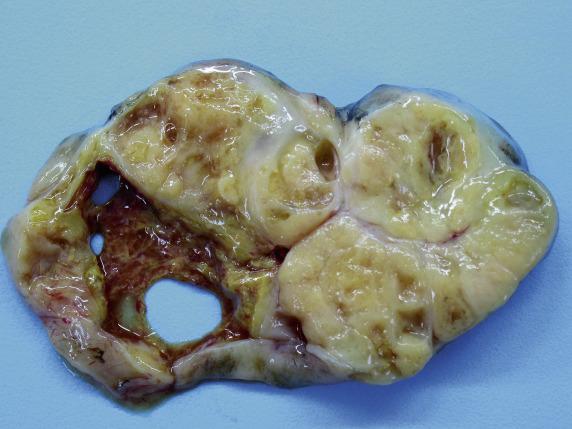
Among all histologic subtypes of lung carcinoma, small cell carcinoma most commonly metastasizes to the ovary. The tumor cells may be arranged in sheets, trabeculae, or nests. They are small to intermediate in size and have a high nuclear-to-cytoplasmic ratio, hyperchromatic nuclei, nuclear molding, inconspicuous nucleoli, and brisk mitotic activity. Other histologic types include adenocarcinoma, large cell carcinoma not otherwise specified (NOS), and, rarely, squamous cell carcinoma ( Fig. 17.32–17.33 ).

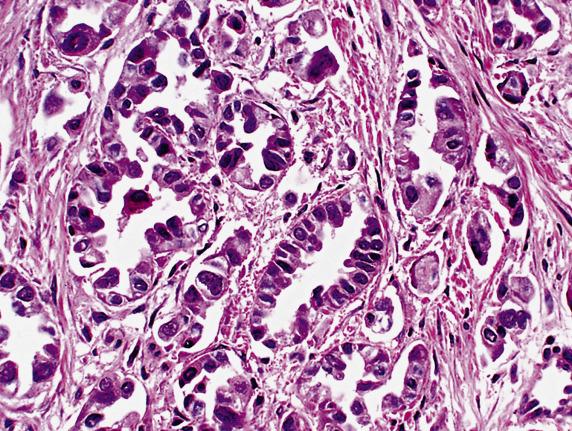
Small cell carcinoma expresses low-molecular-weight cytokeratin (CK8/18), TTF1, chromogranin, synaptophysin, and CD56. TTF1 is also expressed in 75% of adenocarcinomas, which are also typically positive for CK7 and Napsin-A ( Figs. 17.34 and 17.35 ). Approximately half of large cell carcinomas express TTF1 and can be positive for Napsin-A, whereas squamous cell carcinomas are typically positive for CK5/6, p63, and p40 but negative for Napsin-A and TTF1.
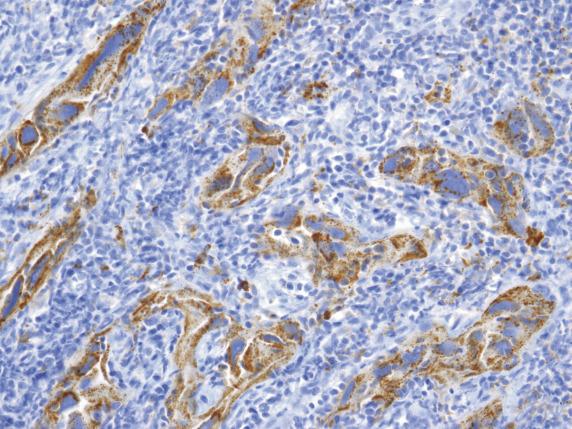
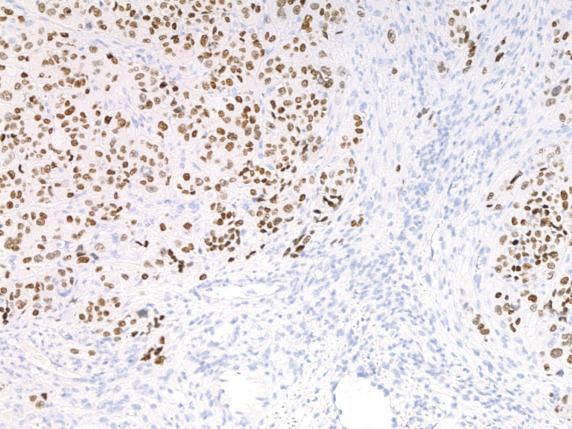
The main diagnostic differential of pulmonary small cell carcinoma is a primary ovarian pulmonary-type small cell carcinoma . Laterality is not helpful; however, the presence of a lung mass favors a pulmonary origin. Although their immunophenotype overlaps, TTF1 expression is much more common in small cell carcinoma of the lung (96% vs. 7% in extrapulmonary small cell carcinomas). In some instances, definitive distinction may not be possible. Less commonly, metastatic small cell carcinoma of the lung should be separated from small cell carcinoma of the hypercalcemic type and rarely from other small round cell tumors. Small cell carcinoma of the hypercalcemic type occurs more frequently at a younger age, two-thirds of patients have elevated calcium serum levels, follicle-like spaces are common, nuclei have conspicuous nucleoli and clumped chromatin, and the tumors are typically negative for TTF1 and show loss of SMARCA4 expression.
Other pulmonary carcinoma types should be distinguished from a primary ovarian neoplasm. For lung adenocarcinoma, the differential includes endometrioid carcinoma (background of endometriosis or adenofibroma, PAX8 and ER positive, and TTF1 and Napsin-A negative) and mucinous carcinoma (background of borderline tumor, Napsin-A, and TTF1 negative). For squamous cell carcinoma, careful tumor examination is suggested to exclude the possibility of a primary ovarian squamous cell carcinoma arising in a mature cystic teratoma.
Commonly unilateral
Mean size 10 cm
Lobulated, white to yellow, hemorrhagic, and necrotic
Cystic change common
Small cell carcinoma most common
Diffuse, trabecular, or nested growth
Small to intermediate-sized cells
High nuclear-to-cytoplasmic ratio, hyperchromatic nuclei, inconspicuous nucleoli, and brisk mitotic activity
Conspicuous nuclear molding
Other types: adenocarcinoma > large cell carcinoma > squamous cell carcinoma
Small cell carcinoma: low-molecular-weight cytokeratin (CK8/18), TTF1, chromogranin, synaptophysin, and CD56-positive typically positive
Adenocarcinoma: CK7, Napsin-A, TTF1 (75%) positive
Squamous cell carcinoma: CK5/6, p63, and p40 typically positive but Napsin-A and TTF1 negative
Large cell carcinoma (NOS): TTF1 positive (45%) and Napsin-A negative
Pulmonary small cell carcinoma
Ovarian small cell carcinoma, pulmonary type
Ovarian small cell carcinoma, hypercalcemic type
Adenocarcinoma
Mucinous and endometrioid ovarian carcinoma
Squamous cell carcinoma
Squamous cell carcinoma arising in mature cystic teratoma
Patients range in age from 34 to 73 (mean 55) years and typically present with abdominal distention/fullness, bowel obstruction, or an adnexal mass.
The majority of tumors are unilateral (mean 13 cm). They are frequently cystic but may have a solid component.
The most common histologic type to metastasize to the ovary is papillary urothelial carcinoma, which is characterized by large papillae projecting into cystic spaces and lined by atypical (low- or high-grade) stratified epithelium. Infiltrating nests with central cystic change secondary to necrosis and desmoplastic stroma may also be seen ( Fig. 17.36 ). Importantly, these tumors may show squamous and/or glandular differentiation. The next most common histologic type is adenocarcinoma with signet-ring cells (signet-ring cell carcinoma), in which the cells infiltrate individually or form trabeculae or sheets; a minor glandular component can also be seen. Rarely, urachal adenocarcinoma (with variable degrees of mucinous differentiation) metastasizes to the ovaries and has the appearance of a mucinous carcinoma.
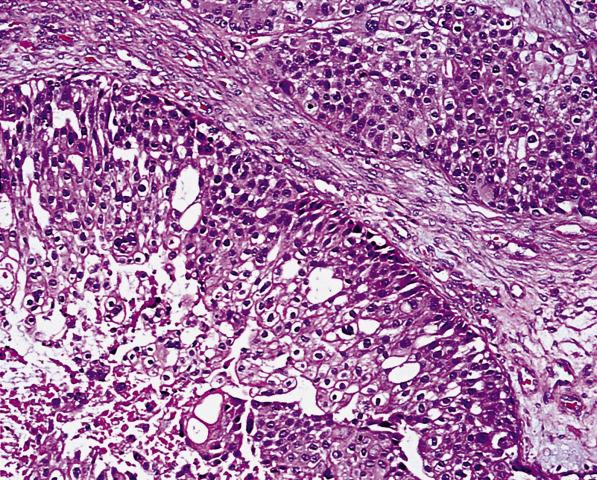
Urothelial carcinomas of the urinary bladder express CK7 and CK20, usually at significant levels ( Fig. 17.37 ). They also express GATA3, uroplakin, and thrombomodulin, but are negative for WT1 (N-terminus).
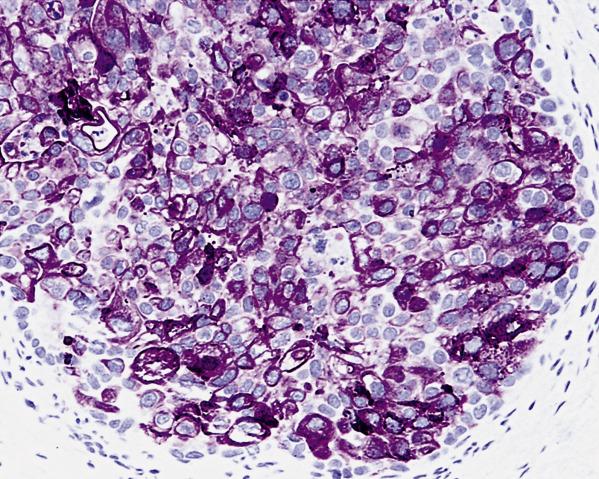
It may be difficult to distinguish metastatic urothelial carcinoma of the urinary bladder from a Brenner tumor (benign, borderline, or malignant) and high-grade serous carcinoma with transitional morphology . Histologic features that favor a metastasis over Brenner tumor include ovarian surface involvement and lymph-vascular space invasion; laterality is not helpful. Benign Brenner tumor lacks the cytologic atypia and the complex papillary architecture seen in urothelial carcinoma. Borderline and malignant Brenner tumors, which are exceedingly rare, usually have benign-appearing areas, which facilitates their diagnosis. In general, Brenner tumors are positive for CK7, GATA3, and p63. Moreover, they may be positive for uroplakin and thrombomodulin, an immunohistochemical profile that extensively overlaps with metastatic urothelial carcinoma; thus, distinction between the two is based on clinical history and general features of metastatic disease. Serous carcinomas with transitional growth tend to have areas of classic morphology and, unlike urothelial carcinoma, are positive for PAX8 and WT1 but negative for GATA3 and p63. p16 and p53 should be used with caution in this context, as high-grade urothelial carcinomas can show abnormal expression for these markers.
Ovarian involvement by carcinoma of the kidney is rare and represents <1% of clinically apparent metastases from nongynecologic tumors. Patients range in age from 17 to 64 (mean 49) years and present with a pelvic/adnexal mass, abdominal mass, ascites, or vaginal bleeding.
Approximately 20% of tumors are bilateral, ranging from 7 cm to 18 cm. They are typically solid but may have a cystic component. The cut surface is nodular, tan, yellow or brown, and shows variable amounts of hemorrhage.
Conventional (clear cell) carcinoma is the most common histologic subtype of renal cell carcinoma that metastasizes to the ovary. It is typically composed of nests or tubules, some cystically dilated, associated with a conspicuous sinusoidal vasculature ( Fig. 17.38 ). Alveolar and solid growth patterns may also be seen. The tumor cells are polyhedral, cuboidal, and/or columnar with abundant clear cytoplasm and nuclei of varying sizes ( Figs. 17.39 and 17.40 ). The tubules and cysts may contain colloid-like secretions or blood.
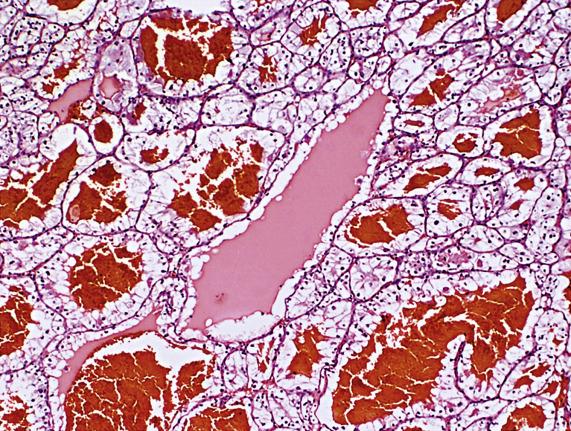

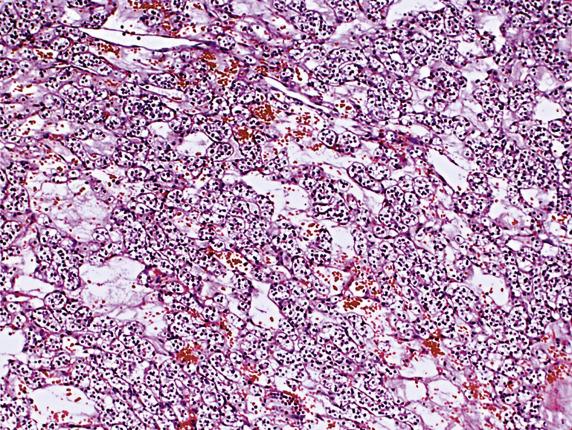
Become a Clinical Tree membership for Full access and enjoy Unlimited articles
If you are a member. Log in here